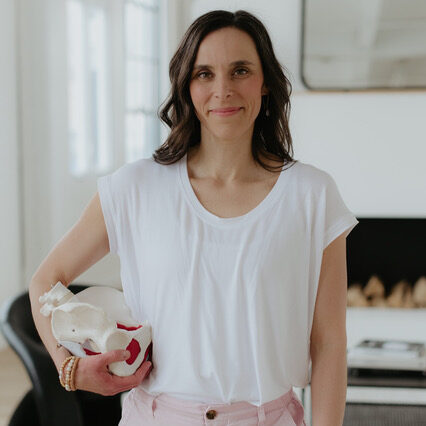Registered Orthopeadic & Pelvic Floor Therapist
Registered Kinesiologist
Why Should I Exercise After Having a Baby?
When your new baby arrives, self-care and healing might be the last things on your mind. However, just as preparing your body during pregnancy is vital, so is taking care of it after childbirth. Your body has undergone a lot, and maintaining a healthy lifestyle is an investment in both your present and future well-being.
Research shows that staying active after pregnancy can speed up recovery, boost your mood, prevent postpartum weight retention and reduce your risk of postpartum depressive symptoms (ASCM, 2013). Along with staying active, being aware of your pelvic floor health is equally important. Losing control of your bladder when you sneeze right after childbirth might be normal, but preventing pelvic floor issues from surfacing later in life is sometimes overlooked by new moms.
Let’s dive into what post–natal fitness training entails and why pelvic floor health plays a crucial role in your postpartum recovery.
When Should I Start Training?
Your body has been through a lot and is still in recovery mode, so it’s essential to resume physical activity gradually. Every body, pregnancy and delivery is unique and therefore, your exercise routine should reflect that individuality.
Factors such as vaginal vs. cesarean delivery, and the presence or absence of medical complications influence postpartum activity. Work with your health care team to determine when it’s safe to return to exercise after delivery (ASCM, 2013).
“Strength training in the postpartum period should start gradually with a ‘pelvic floor muscle first’ focus.”
(ASCM, 2013)
What to Expect from Post-Natal Fitness Training
Returning to fitness after delivering your baby can feel daunting, especially with the demands of caring for your new addition. Don’t let this overwhelm you – taking care of yourself is crucial, and you don’t have to do it alone.
As personal trainers, our primary goal is to get you moving safely and confidently again, after getting clearance from your health team. Each person will have specific post-natal fitness needs that are dependent on a variety of factors. To tailor our approach, we start with a fitness and lifestyle assessment, which helps us to understand your pre-pregnancy fitness level, your pregnancy journey and post-natal fitness and health goals. Informed by the results of the assessment, we create a program best tailored to your needs and goals.
Your program will be unique to your areas of focus, but typically your trainer will work with you in areas such as:
- Pelvic floor exercises to regain control and endurance
- Postural and corrective exercises to support your new lifestyle and/or reduce pain
- Mobility exercises
- Gentle aerobic exercises
- Progressive compound exercises to improve strength or work towards goals
- Progressing to high-impact activities, such as running or jumping
Providing the best care often involves collaborating with other health professionals with expertise in specific areas. A post-partum training program should include your personal trainer collaborating with your healthcare team and other specialists.
Why is the Pelvic Floor Important?
We know that the pelvic floor plays a critical role in post-partum health, so we reached out to Kathleen White, a registered Orthopedic and pelvic floor physiotherapist who has been practicing for 15 years.
Your pelvic floor is a group of muscles that sit inside your pelvis. It plays several major functions in the body including:
- hold your organs up and supports the baby in your uterus
- it plays a role in your core function
- it helps to prevent incontinence
- and it plays a role in sexual function
No matter how your baby is delivered, the pelvic floor gets loaded and stretched out during pregnancy. Therefore, taking a pelvic-floor first training approach after giving birth, and seeing a pelvic floor physiotherapist, should be the new normal – and not just so you don’t pee your pants when you sneeze.
Why is a Pelvic Floor Physiotherapist Important?
After childbirth, your body heals in various ways depending on multiple factors. Pelvic Floor Physiotherapists are registered healthcare providers with specialized training in supporting women during and after pregnancy. They assess and treat the pelvic floor to aid recovery and address any post-partum symptoms. Often collaborating with personal trainers, they create tailored exercise plans to help you regain strength progressively. This support is crucial for a successful rehabilitation journey.
Regardless of your fitness level before pregnancy, some deconditioning is inevitable. Strengthening your body during the postpartum period not only supports you as your baby grows but also prevents future issues. Many women avoid physical activity due to incontinence or pelvic health concerns. This avoidance can significantly impact their quality of life since regular exercises reduces the risk of heart disease, depression and maintains strength and bone health.
Building a strong foundation now and improving pelvic health post-birth ensures a better quality of life in later years. Early postpartum physical activity also reduces anxiety and depression, helps you connect with other parents, and builds the strength needed to care for growing your baby, helping you feel more like yourself again.
Conclusion
Combining the expertise of a personal trainer with the specialized knowledge of a pelvic floor physiotherapist offers the most holistic approach to post-natal health and fitness. This partnership ensures that all aspects of your recovery are addressed, from physical strength and mobility to pelvic floor health. This 360-degree approach not only helps you recover faster but also sets a strong foundation for long-term health and well-being.
Ready to embark on your post-natal fitness journey? Reach out today to get started on a personalized program designed to support your recovery and help you thrive in your new role as a parent.
References:
American College of Sports Medicine. ACSM’s guidelines for exercise testing and prescription. Lippincott Williams & Wilkins; 2013 Mar 4.
Kathleen White, Registered Orthopeadic and Pelvic Floor Therapist


